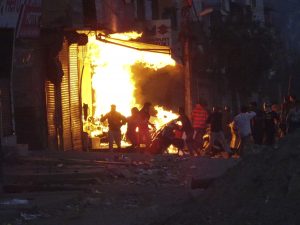U.S. President Donald Trump visited India last week for the first time. The trip packed in a massive welcome rally in Indian Prime Minister Narendra Modi’s home state of Gujarat – one that Trump is unlikely to forget – and an array of deals touching upon defense, telecom, energy, and so on.
Modi wished to use Trump’s visit for various political and economic gains. The Modi government has suffered from international backlash against policies such as the controversial Citizenship Amendment Act (CAA) and the lockdown in Kashmir. This was an opportunity for Modi to rebuild his image. Further, India is also in desperate need of foreign investment to fight record levels of unemployment and boost sagging demand in its economy.
Yet, for the most part, these objectives were undermined during Trump’s visit, as the world’s eyes were transfixed elsewhere. Not far from Trump’s hotel in Delhi, communal riots erupted, resulting in an ever-increasing death toll and pulling away the attention of the international press corps who were accompanying the president. The riots turned out to be Delhi’s worst since the 1984 communal violence against the Sikh community. And even Trump himself admitted to having talked to Modi about the importance of religious freedom during their meeting.
For India, the foreign policy costs of the riots in Delhi are very real. In his engagement with the U.S. president, Modi has sought to win favors through the overt projection of Indian soft power – particularly by showcasing the loyalty he enjoys among India’s diaspora in the United States. The “Howdy Modi” rally in Houston last year was a big part of that – as was the grand reception Trump received in Gujarat, where a reported 100,000 people came to hear him speak.
But in the aftermath of the CAA, and the riots which were closely related to it, much of that loyalty has been noticeably diluted. For days, sections of the Indian diaspora – from across communities – have been protesting in front of Indian consulates in the U.S. against what they see as a desecration of Indian values. “I grew up in an idyllic idea of a secular India,” one protester, Ishita Srivastava, told Al Jazeera in New York. Several Indian academics and students – all of whom have been unofficial ambassadors of Indian soft power in the United States for years – have also long been repulsed.
The problems extend beyond just the diaspora. For years, Indian soft power in Washington has stemmed from the fact that New Delhi enjoys bipartisan support in the United States. That has now been squandered away quite publicly. In recent days, Democrats have joined in to condemn the violence and the preceding anti-Muslim rhetoric from BJP leaders. Following Trump’s refusal to address the riots during his trip, Democratic presidential frontrunner Bernie Sanders tweeted, “This is a failure of leadership on human rights.”
On the economic front, too, the riots have compromised Modi’s objectives. While Trump has been grateful to New Delhi for the flattering welcome he received, the president’s pleasure alone is not going to bring American investment into India. Foreign investors go to countries with strong records of rule of law and reliable stability. And international coverage over the riots has hurt India’s credentials on both counts, in the eyes of many foreign observers, investors and decision-makers. One particularly scathing article in The Atlantic called the violence a “pogrom” and indicted the government in instigating it.
Such comments have been exacerbated by the Delhi Police’s own behavior during the riots. Reports have either pointed to the police force’s incompetence in responding to the riots, or have carried damning instances of its direct complicity in the violence. In one gruesome video circulated in the media, a group of severely injured men were beaten up and forced to sing the national anthem – right in front of police officers in riot gear. One of the men subsequently died.
Given its status as the capital city of India, the police force in Delhi comes under the direct control of India’s Union Home Ministry. For investors who watch the violence unfold, that makes things much worse: the breakdown in law and order in the capital city – during the visit of the U.S. president, no less – is bound to test their trust in India’s commitment to law enforcement. And if the Union government itself cannot be trusted to uphold law and order in the capital, investors would be justified in being skeptical about their security in the rest of the country.
From polarizing the diaspora to hurting investor confidence, the Delhi riots will impact India’s engagement with the U.S. and the world. Trump’s visit proved somewhat counterproductive by bringing the international spotlight onto India’s ongoing communal tensions. The political and economic costs of the riots could linger on for much longer than the riots themselves.

































